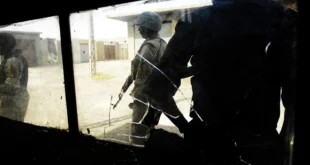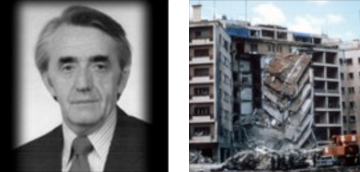
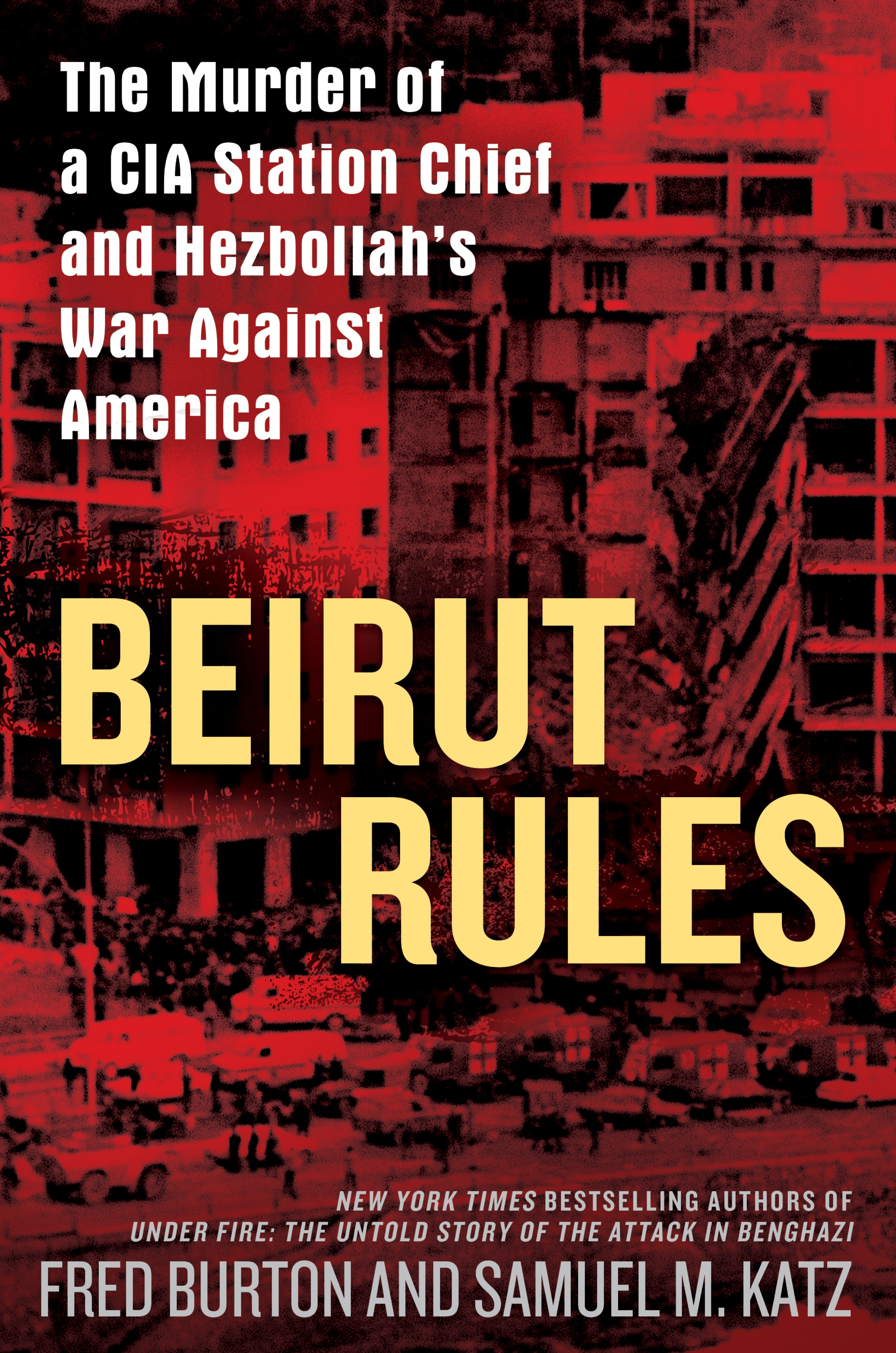
Interview With Author Fred Burton Hijacking, Bombings of U.S. Embassies: Beirut Ground Zero for Intelligence Operations
Fred Burton, a New York Times bestselling author, former counterterrorism agent with the U.S. State Department’s Diplomatic Security Service and Chief Security Officer at Stratfor, a geopolitical intelligence firm, discusses his latest book, Beirut Rules. Co-written with Samuel M. Katz, Beirut Rules recounts the story of CIA Station Chief William Buckley who was kidnapped and later murdered in Lebanon by Hezbollah during the 1980s. The only kidnapping of a CIA station director at the time.
- What made you want to tell the story of William Buckley, a veteran of the 1st Cavalry Division during the Korean War, Special Forces during Vietnam and a long career with the Central Intelligence Agency?
Fred – I wanted to tell the story of an American hero. I had worked on Bill’s case as an agent with the State Department and knew that he was special. He had fought in two hot wars and gave his life in the shadow war.
Sam – William Buckley was a true American hero and one who fought conventional enemies and those in the shadows. He volunteered to undertake an impossible assignment against an enemy his agency and this country gravely underestimated. That story personifies in many ways America’s experience in the Middle East in the last 35 years.
- Beirut Rules isn’t just about William Buckley. It’s also a detailed recount of everything happening around him during that time. What made Beirut such a focal point for the United States, other foreign powers and terrorist groups at that time?
Fred – It was the center of gravity for global terror, due to Hezbollah. All roads led to Beirut.
Sam – Beirut was a fault line in not only the Arab-Israeli conflict but also the Cold War, where U.S. and western interests clashed with Soviet and Warsaw Pact interests. Most importantly, Lebanon was where the new player in Middle East mayhem, the Iranians, decided to stake their claim to partial ownership of the Middle Eastern battlefield.
What was it like for William Buckley, or any American at that time, to live and work in Beirut? What risks were they taking?
Sam – The city was fraught with danger but life went on. People went to the beach, ate out and enjoyed the voracious Lebanese nightlife. There were deals cut. Militias controlled checkpoints that divided the city avenue by avenue; the city was already divided into East (Christian) and West (Sunni) and South (Shiite) Beirut. People were killed in the chaos, and they were kidnapped. It was, at the time, the most high threat posting anywhere.
- You’re not just writing Beirut Rules as a historian, are you? Weren’t you there on the ground during part of this time?
Fred – As a member of the Hostage Location Task Force, we were laser focused on finding Bill Buckley and all of the other Western hostages. We figured if we found Bill, he would be with the others.
- Two key and well publicized incidents described in the book include the bombing of the U.S. Embassy in Beirut as well as the bombing of the Marine barracks in 1983 that left 241 Marines dead. Why did you choose to release the book on the 35th anniversary of the barracks bombing?
Fred – The release date was the publishers call.
- Iran-backed Hezbollah and its leadership also play a key role in Beirut Rules. What did this period mean for the evolution of that group?
Fred – Hezbollah was supported and funded by Iran. In essence, Hezbollah’s was Iran’s hired guns and hitman, used as a tool of foreign policy.
Sam – Hezbollah was dependent on Iranian money and influence (religious justification) and Syrian permission to move and operate freely (Syria did and does consider Lebanon to be part of Greater Syria). As a result, its operations had to fit neatly within the parameters of both Iranian and Syrian interests. The situation hasn’t changed, though Hezbollah has emerged as the world’s most powerful terrorist army and the world’s most dangerous organized crime and narcotics smuggling entity.
- Has Hezbollah ever taken responsibility for Buckley’s death or any of the Americans kidnapped during that time?
Fred – No
- What parallels do you see between this era of violence and instability in Lebanon of the 1980s and what we see today in the region? Or how has it changed?
Fred – Being a Middle-East analyst is a job for life. Same actors and players engaged today as it was in 1985.
- Some CIA veterans have said they did not think this story could have ever been told. What was your experience working with the U.S. Department of Defense, CIA and Buckley’s family to pull the story of Beirut Rules together?
Fred – We got hordes of cooperation from the old boy network of spooks and spies. It was a true honor to listen to their warm tales about Bill. Some material was redacted by IC, but that is to be expected with a book like this. It took 11 months to get cleared by Uncle Sam. We were also honored to receive the cooperation from Bill’s survivors, specifically his sister and longtime companion. Both were protective and rightfully so, but were a true pleasure. They provided great insights about Bill and original photos that are amazing.
Sam – William Buckley’s kidnapping was a point of no return in the Middle East—it shaped the way the spies did business in locations such as Lebanon and impacted Middle Eastern tradecraft. Many in the shadows wanted this story told. It was an important history and it was important to give William Buckley his due and the honor his service and sacrifice deserve.
- What is it in this story that resonates today as we see a new generation of American men and women deployed around the world in service of country?
Fred – A life of service and the ultimate sacrifice for country. Bill Buckley ran towards danger, when few wanted to go. He gave all.
Sam – William Buckley was a quiet hero. His entire existence was about service, sacrifice, and courage. There should be schools named after him and his image should be on a postage stamp. He embodied everything that is honorable and stoic about this nation.
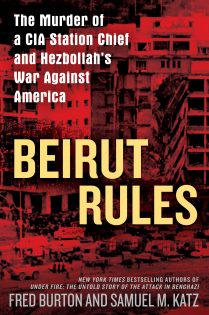
THE PREAMBLE TO DISASTER
The shahada [martyrs] are the candles of society. They burn themselves out and illuminate society.
If they do not shed their light, no organization can shine.
—Iranian Ayatollah Morteza Mutaharri
The Israeli military headquarters in Tyre was a seven‑story high‑rise situated inland from the sea, and the site from which most of Israel’s security and intelligence operations in southern Leba‑ non were controlled. The building was the administrative nerve center for Israel Defense Forces units operating in the area, and it housed two companies of Border Guard policemen as well. The Border Guards, Israel’s paramilitary police arm, were in Lebanon to maintain law and order in the towns and villages of southern Lebanon. The policemen represented the mosaic of Israeli society and included Jews, Druzes, Bedouins, and Circassians. Many of the Border Guard personnel spoke Arabic, and many had spent careers policing a hostile population in the West Bank and the Gaza Strip. The building was more than just a military garrison. The Tyre facility was the Israeli intelligence hub in southern Lebanon. A’man, Israeli military intelligence, ran many of its human intelligence (HUMINT) operations. Handlers from the ultra‑secretive Unit 504, the military intelligence unit that ran agents behind enemy lines, used the regional headquarters as a safe and comfortable location where assets could be debriefed and espionage endeavors coordinated.
The Shin Bet, Israel’s domestic counterintelligence and counterterrorist agency, was also based inside the building. The Shin Bet was responsible for all counterterrorist investigations in southern Lebanon and for rounding up the last vestiges of Arafat’s legions in southern Lebanon.
Business was booming for the Shin Bet. The basement holding cells were full of Lebanese and Palestinian men suspected of belong‑ ing to one popular front or another. The detained were often a remarkable source of information.
Many of the men serving inside the headquarters building were reservists—from Israel’s citizen army, doing their annual thirty‑day stint of call‑up service. The reservists were a mixture of middle‑aged men happy to have a few weeks away from wives and kids, and men young enough still to be in school, still trying to save enough to get married, and still holding on to dreams of lives out of uniform. Captain Dubi Eichnold, the commander of the Military Police investigative unit at the base, was preparing a small party for some of the officers that evening, November 11, 1982; it was to be a celebration to mark the halfway point of the reservist stint for him and his team. A small feast, including snacks and soft drinks, was being readied for the party. Everyone was itching to go home.
Captain Eichnold was already sitting with a few of his fellow officers in the mess hall at 7:00 that Thursday morning. The officers were in full kit, battle rattle at their sides. An electric space heater failed to mitigate the bone‑numbing cold and the officers wore their olive green winter parkas as they guzzled cup after cup of army‑issue rocket‑fuel‑grade coffee. Upstairs, the Border Guard’s morning garrison was getting ready for morning roll call. Downstairs, the prisoners in the holding cell had already eaten. Some were in the middle of morning prayers.
The military policeman standing guard outside next to a small embankment of sand bags could hear the clanking of metal forks scraping plastic plates and he smelled the eggs cooking. He hoped that someone would bring him a cup of coffee soon. A white Peugeot 504 appeared from the west, speeding toward the headquarters building. The rain had intensified. The sky darkened.
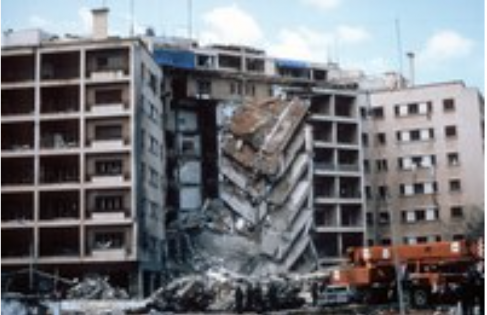
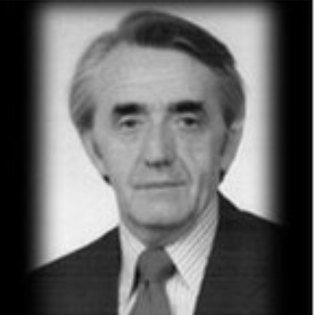
At 7:15 on the morning of November 11, 1982, the Israeli military head‑ quarters in Tyre collapsed in a blinding flash of light, the seven stories reduced to rubble beneath a rising plume of black smoke. At the time, more than a hundred Israeli soldiers, policemen, and spies had been inside the building; many of those not killed instantly became trapped inside tiny air pockets, their bodies bloodied by the explosion and de‑ bris. The Israel Defense Forces had little experience in pulling survivors out of a building hit by a catastrophic blast—there had never been a need; a terrorist might throw a hand grenade into a crowded cinema, but he didn’t demolish a building. Rescues were done painstakingly by hand. Combat engineers were flown in, and helicopters shuttled the wounded to awaiting trauma care thirty‑five miles away at the Ram‑ bam Medical Center in Haifa. The dead were removed, the shattered bodies covered with coarse, olive‑colored blankets. Rain created puddles that formed cement‑like patches of caked‑together blood and dust. By nightfall, the magnitude of the calamity was apparent: sixty‑seven IDF and Border Guard personnel were dead, along with nine Shin Bet agents and fifteen local detainees. November 11, 1982, was one of the deadliest days in Israeli military history.
Few understood it yet, but the attack represented a new struggle for Lebanon’s soul—and one that would be pursued with a new tactic, suicide bombing. The man responsible for the destruction wasn’t even a man yet. Ahmed Qasir was a fifteen‑year‑old boy when he drove the explosive‑laden Peugeot 504 that destroyed the Israeli military head‑ quarters. He had lived an unexceptional existence in the Shiite village of Dir Qanoun an‑Nahr, located in the foothills ten miles north of Tyre—a setting more akin to the last century but beset by the horrors of twentieth‑century destruction. He attended the local mosque, but left school after the fifth grade to work at his father’s vegetable stall in the village market. According to reports, Ahmed was never a shooter— someone who took up arms against the Palestinians or the Israelis—but he did associate with local young men who carried their AK‑47s openly, and he began to embrace the Khomeini‑brand fanaticism‑laced Shiite Islam. Excerpted from BEIRUT RULES: The Murder of a CIA Station Chief and Hezbollah’s War Against America, published by Berkley, an imprint of Penguin Publishing Group, a division of Penguin Random House, LLC. Copyright © 2018 by Fred Burton and Samuel M. Katz
BELOW CIA FILES
Remembering CIA’s Heroes: William F. Buckley
Currently, there are 113 stars carved into the marble of the CIA Memorial Wall. The wall stands as a silent, simple memorial to those employees “who gave their lives in the service of their country.” The CIA has released the names of 80 employees; the names of the remaining 33 officers must remain secret, even in death.
 William F. Buckley, a legendary Agency officer, died on June 3, 1985 after enduring 14 months in terrorist custody. Bill was abducted in Beirut, Lebanon, which set off one of the most grueling periods in the CIA’s history. His legacy of bravery and resolve has inspired Agency officers who have followed in his footsteps.
William F. Buckley, a legendary Agency officer, died on June 3, 1985 after enduring 14 months in terrorist custody. Bill was abducted in Beirut, Lebanon, which set off one of the most grueling periods in the CIA’s history. His legacy of bravery and resolve has inspired Agency officers who have followed in his footsteps.
Early Years:
Bill joined the CIA after distinguishing himself during the Korean War as Company Commander with the US Army’s 1st Cavalry Division. His heroism was on full display when he captured a North Korean machine gun nest, an act of valor that earned him a Silver Star. His military valor also earned him two Purple Hearts, the Vietnam Cross of Gallantry, and a Combat Infantry Badge, among other awards.
Life at CIA:
Elements of Bill’s career at the CIA remain classified, but he was one of the first Agency officers to grasp the growing threat from international terrorism. In the late 1970s, for example, Bill helped develop the Incident Response Team and the Counterterrorism Group, the forerunner to today’s Counterterrorism Center. His assignments took him around the globe, as there was no mission that Bill would turn down.
It came as no surprise to Bill’s colleagues that he volunteered to serve as the CIA Station Chief in Lebanon following the 1983 Beirut Embassy bombing, the deadliest attack in CIA history. Underscoring his bravery, Bill took the assignment acutely aware of Beirut’s high threat environment, which had included credible threats against other US officials posted there. Bill immediately brought energy and focus to the primary mission: countering the terrorists that had taken the lives of several CIA colleagues, as well as State Department and Military counterparts.
His Last Mission:
It was in the service of this mission on a clear March morning that Islamic Jihad operatives kidnapped Bill while he was en route to work. Despite a government-wide rescue effort, Bill died in captivity on June 3, 1985.
The CIA that year held a memorial service and honored him with a star on the Memorial Wall and with the Distinguished Intelligence Cross, the CIA’s highest honor. In 1988, Bill was symbolically laid to rest at Arlington National Cemetery with full military honors, and his remains were returned to the United States in 1991.
In a statement released on March 16, 2014, on the anniversary of Bill’s abduction, CIA Director John Brennan spoke of Bill’s heroism and legacy:
We remember Bill not for the manner in which he died but for the legacy he left behind. From his time as an Army Lieutenant Colonel to his tenure with the Agency, Bill inspired those around him to do great things despite often dangerous conditions. Those of us who knew Bill were fortunate enough to witness his courage firsthand, but his legend is one that continues to captivate and inspire a younger generation of officers.
FLASHBACK: April 18, 1983: U.S. Embassy Attacked in Beirut
On April 18, 1983, a suicide bomber crashed a truck into the front of the U.S. Embassy in Beirut, Lebanon, and detonated approximately 2,000 pounds of explosives. The massive blast killed 63 people, including 17 Americans, some of whom were CIA officers.Unrest in Lebanon
In September 1982, the Multinational Force in Lebanon, composed of U.S. and European military personnel, entered Lebanon to help the Lebanese government maintain stability during the third phase of the Lebanese Civil War (1982-1983). Extremist groups demanded the departure of U.S. and Israeli personnel, who were on the outskirts of Beirut. Among the most active of these groups were Lebanese Hezbollah and the Islamic Jihad Organization. The Islamic Jihad Organization engaged in a campaign of kidnappings and attacks, and claimed responsibility for the Beirut embassy bombing.
The aftermath of the attacks brought about swift action from Agency and diplomatic officials. Then-Secretary of State George Shultz tasked an advisory panel to investigate the security of diplomatic facilities overseas. The resulting report, informally known as the Inman Report, led to security improvements at embassies, the relocation of many CIA officers to more secure locations, and the creation of the State Department’s Bureau of Diplomatic Security and Diplomatic Security Service, which is the law enforcement arm of the U.S. Department of State.
The Fallen
The Beirut embassy bombing remains the most lethal attack in the Agency’s history. Several Agency officers were lost; among them were a senior NCS officer visiting the embassy that day, the Agency’s senior officer in Lebanon, and a support officer reporting for her first day at work. All of the fallen are honored with stars engraved on the CIA Memorial Wall at CIA Headquarters.
 Soldier of Fortune Magazine The Journal of Professional Adventurers
Soldier of Fortune Magazine The Journal of Professional Adventurers






